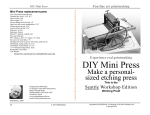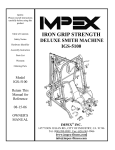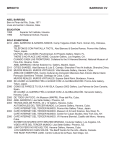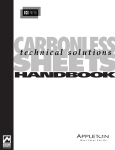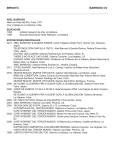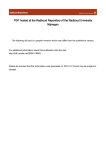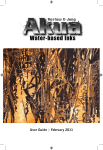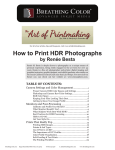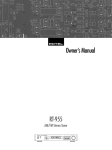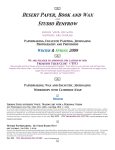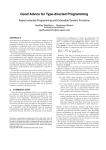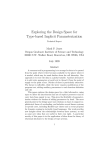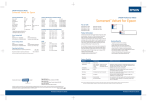Download User Manual-Web - PrintmakingWorld
Transcript
Sustainable printmaking experiences DIY Mini Etching Press Make a personal-size etching press User Manual Above: The Mini Etching Press is shown is shown after assembly, with the quarter-inch chase on the press bed. The photographs inside—and videos online—appear varied because they show models in different woods and are finished in different ways. Originated by Bill Ritchie, Co-designer of the Mini Etching Press 2 Step 1—Detailing your press The DIY Kit Mini Etching Press will work without the three wood parts being finished. The owner can choose whether to stain, oil, varnish, paint, decorate by carving and engraving or combinations of wood finishing. Sanding, additional decorative routing, etc., there are many possibilities to customize your press The round space on the passive side is for a badge, which you can make in any material or which you can order from the factory, as either a blank brass, copper or aluminum disc or etched with the standard design or a design you provide. For information, email [email protected] Sand before staining or oiling, start with 120 sandpaper, then steel wool to polish. Among embellishments are the laser print transfer with a hot transfer tool. A 1 3/4-inch space has been made for a round badge you create or have custom-made for you. Staining, oiling, or painting comes after sanding. Teak or Tung oils are popular. Some stains have the oil included. Follow the instructions by the maker. Test the finishing product on your embellishments before proceeding. Video under construction © 2013 Bill Ritchie 3 Make a badge for your Mini Etching Press The Halfwood Press Line had various decorative touches and there is a cut-out on the passive side of the Mini Etching Press to continue this tradition but with a twist—you can also make your own. Using wood, leather, plastic, metal or cast resin, found objects or recycled printing plates—almost anything you can find or create will be your press’ badge. The badges at Halfwood Press Workshops are often made of 22-gauge brass. The design is made on a computer, printed by laser on silicon transfer paper and then ironed on to the brass. The fused laser toner acts as a resist so when the brass badge is immersed in Edinburgh Etch, only the exposed parts are eaten away. The badge is cut out and filed until it fits in the cutaway, then it is glued in with epoxy glue. Before you get started, know this: The press you receive was assembled at the factory, then it was taken apart to ship. This manual was written and videos made while disassembly and reassembly so everything was included. On the next page is the list of parts and the tools needed. Some features about the press • • • • Each press is hand-tooled, so the parts are not interchangeable with ALL other of the same model. Some parts are marked A and P for Active and Passive, and if the instructions call for these to match, you must. The “tuning” of the press is important for the smoothest functioning; balancing the tightness of screws and nuts is explained in the instructions. You can always email for support— [email protected]—and use Skype by appointment. © 2013 Bill Ritchie 4 Tools included Allen wrench, size 5/64” (2 each) Allen wrench size 1/8” (1 each) Philips screw bit for barrel nuts, in-handle combo Open, box-end combination 5/16” wrench Materials, supplies you need Printmaking paper (for testing the finished press) Light machine oil (3-in-1) Test plate 1 3/4” diameter badge blank Parts and accessories in the kit 1. Hood piece, drilled and tapped 2. Open-end wrench, 5/16 open, box end combination 3. Hood hex socket screws, 5/32” (4) require the 5/64” Allen wrench 4. Mini Press core, pre-assembled, 1 1/2” solid rollers with precision bearings, pressure screws and synchronizing chain, drive shaft fitted with spur gear for driving the bed rack and four cross-ties, two with 4 bearings 5. Customized Philips screw driver bit, 1/4” 6. Hood barrel nuts, 5/32” (4 each) 7. Allen wrenches, (1) 1/8” and (2) 5/64” 8. Custom 3/16” barrel nuts for core and cross-ties (12 each) 9. Cross ties (2) 3/16 threaded rod fitted with bearings and jamb nuts 10. Two hardwood side pieces, (1 active, 1 passive) 11. Mini Press bed, fitted with steel rack, 1/4” polycarbonate, 6” X 14 1/2” 12. Wheel with 1/4” set screw (accepts the 1/8” Allen wrench) 13. PVC Chase, cut for 5" X 7" format for 1/4" thick printing block 14. New sizing catcher and roller felt blankets, 6” X 12” 15. Manual (this manual, not shown in the photos) The 5/16 open-end, box end combination wrench is provided, as is the driver kit, which has five parts fitted inside the hollow handle. The driver shaft inserts into the handle, and it is magnetic so that the driver tips do not fall out. Note that only the blunt-end Philips driver is to be used on the barrel cap nuts. © 2013 Bill Ritchie 5 1 4 2 5 6 3 7 8 9 10 1 12 1 1 © 2013 Bill Ritchie 6 Step 2—Attach the hood to the press core The hood is custom fit to each core. The active and passive sides are indicated by the letter A and P on each end, assuring the best alignment of the holes and the barrel cap nuts. The active end matches the side where the driving shaft extends. With the hood in place, the threaded, black 1” hex socket screws are inserted. Using the 5/64” Allen wrench, turn the black screws in until about 1/8” inch remains visible in the recessed holes, allowing for the barrel cap nuts to be fitted on and turned in. The core of the press needs a hood, and the hood is custom fitted to the core. The length of the core is precisely correct for proper tension of the chain. Hood has “Active” (A) and “Passive” (P) ends, made of hardwood and milled to fit the core. It attaches with four threaded screws and cap nuts. Threaded screws are turned into the threaded holes of the hood, leaving about 1/8” for cap nuts. Barrel cap nuts fit the threaded screws and are tightened with the customized Philips hex screw bit. Do not use great force on cap nuts as they are aluminum and therefore liable to strip. See the video input https://www.youtube.com/watch?v=i6xLKvyLEqI © 2013 Bill Ritchie 7 Step 3 – Start two connecting tie rods in the passive side piece ends’ holes The passive hardwood side piece, marked P, has unthreaded holes drilled in the ends to accept the two connecting tie rods, and four holes in the middle to attach the press core. The connecting tie rods also have an active end and a passive end, distinguished by a 5/16” jamb nut which will secure the rod in the final steps of the assembly. The passive end slips through the unthreaded hole at the end of the passive side piece. Cap nuts will fit the end protruding 1/8”inside the hole. Two threaded steel cross-tie rods have a passive end, with jamb nuts and an active end On the passive, side, which is marked with a P, insert the end of the threaded cross tie rod through each hole in the end. These holes are not threaded, so the rod slips in. Be sure it is the end with the jamb nut- - small net on this end of the rod; run the nut all the way to the bearing for best results. With both threaded rod cross tie rods in, set the passive side piece aside for now as it will be attached after the active side piece is secured to the core with its four barrel cap nuts. See the video https://www.youtube.com/watch?v=ptv1Odipolc © 2013 Bill Ritchie 8 Step 4 - Attach the active side piece The active side piece of the Mini Press core has the shaft for the driving wheel and four threaded cross tie rods (which may have temporary nuts on them, to be removed). They extend from side of the core about 1/4-inch. Align the core with the wood active side piece with the five holes and slip the parts together. Use barrel cap nuts to hold the piece in place. Grip threaded rods to keep them from turning while you turn the barrel nut caps. Check the passive side to see that 1/4-inch of threaded rod shows. Check that the distance between the steel sides is slightly over 6 inches, held by the jamb nuts inside. The core has four threaded cross-tie rods ends extending about 1/4”. When the side piece is on, about 1/8” can be seen inside the recessed holes. The barrel cap nuts are aluminum, a soft metal, so do not use too much force because the threads may be stripped or the slots damaged. Use only the custom Philips driver bit; other drivers do damage. Start the barrel cap nuts, being sure they are started straight to avoid stripping the threads, and then tighten them. See the video https://www.youtube.com/watch?v=ptv1Odipolc © 2013 Bill Ritchie 9 Step 5 - Align the passive side with the core In Step 3, the threaded rod cross ties were left waiting. Screw the jamb nuts all the way back next to the bearings, then press the wood side piece onto the core where the threaded rods’ 1/4” extends. When the passive wood side is on, about 1/8” of the rod can be seen in the hole. Use barrel cap nuts to secure the side. Turn each of the cross ties’ active ends into the threaded holes of the active side piece until the ends extend from the recessed hole about 1/8”. Secure with the barrel cap nuts. Screw the jamb nut out to the wood, measure for the 6” bed clearance, then bring the cap and jamb nuts together. With the jamb nuts moved back, fit the side on the four threaded cross tie rods. Turn the threaded cross tie rod into the threaded hole in the active side piece. Turn the threaded cross tie rod until about 1/8” can be seen coming through, out the recessed holes. Start a barrel cap nut on this end, gripping the threaded rod so it doesn’t turn with the nut. Bring the jamb nuts to the wood and secure the cap nut and jamb nut together. Measure to check for 6” bed space. See the videohttps://www.youtube.com/watch?v=ptv1Odipolc © 2013 Bill Ritchie 10 Step 6 - Tighten all the barrel cap nuts and the jamb nuts in the steel core together The barrel cap nuts are aluminum, which is a comparatively soft metal, so do not use excessive force when tightening them and use only the blunt-ended Philips hex driver bit for the barrel cap nuts. They need only be snug. The jamb nuts on the ends of the wood side pieces, located inside the passive side, should be snug against the wood. The purpose of the jamb nuts is to keep the outer cap nut tight against the wood. Use a 5/16” combination wrench for tightening jamb nuts. There are jamb nuts inside the steel core, too, which should be checked again. Use only the blunt-ended Philips driver bit provided for the barrel cap nuts. The jamb nuts in the passive side are to be snug against the wood. Use a 5/16 open-end / box end combination wrench on the jamb nuts. Jamb nuts inside the steel core are important to determine the 6” space where the bed travels, and so, too, the cap nut and jamb nuts on the ends of the side pieces. Video under construction © 2013 Bill Ritchie 11 Step 7—Check the three driving shaft set screws on the spur gear, collar, and hub There are two set screws on the spur gear and one on the retainer collar, a total of three set screws on the drive shaft tightened at the manufacturer’s. Be familiar with these to ensure that they are always tight in keeping your Mini Press in good working order. If the spur gear set screws loosen, it will slip on the shaft. Use the 5/64” Allen wrench to tighten these, remembering never to use worn Allen wrenches. The wheel hub set screw, likewise, must be tightened with the 1/8” Allen wrench. The spur gear has two set screws. The collar has one set screw. There is a fourth set screw on the wheel hub which takes the larger Allen wrench to tighten. Two or three drops of light oil on the threaded pressure screws will make them turn more smoothly. Video unders construction © 2013 Bill Ritchie 12 Step 8 — Attach the wheel The wheel is hand-crafted steel with a 1/4” set screw in the hub. The 1/8” Allen wrench provided is for tightening the set screw. When attaching the wheel, note that there is a flat spot on the shaft for the set screw is to be seated. The flat spot ensures that the hub will not turn on the shaft when you turn the wheel. When tightening the set screw, never use an Allen wrench that shows wear. If it slips, then the edges inside the set screw wear and the set screw cannot be loosened to remove it, nor can it be tightened to prevent the wheel from slipping. The wheel is handcrafted so, if it wobbles when spun, do not worry because does not affect the press’ performance. Use the 1/8” Allen wrench for the driving wheel hub set screw. Loosen set screw to clear the shaft in order to slip it on the shaft to the flat spot where it is to be set. Align the set screw with the flat spot on the shaft and slip the hub on to the shaft. When you are certain the screw is on the flat spot, tighten the set screw all the way down and then tighten it hard so the set screw “bites” into the steel of the flat spot on the shaft. See the video https://www.youtube.com/watch?v=RziRWZh1zk0 © 2013 Bill Ritchie 13 Step 9 - Finishing the press bed The bed is 1/4” thick polycarbonate, sometimes called Lexan after its original industry name. This sheet cut to size, milled and drilled for fitting with a steel rack. As it comes from the supplier, it is covered with protective paper or plastic, and the corners are sharp. For appearance you may want to round the corners and soften the edges and then remove the protective coverings. Recovering with clear, smooth adhesive Contact paper is recommended. Tools for this step are files, knife, squeegee, ruler, cutting surface and a bench stop. Filing corners and edges Measure, cut new covering. Attach covering by one end to the tabletop, with the other end of the bed stopped. Put the Contact paper readingside down. Turn it over and start to peel the backing away about two inches, then drag the squeegee and peel at the same time all the way to the end. A window-washer-style squeegee is ideal to helping avoid bubbles. If bubbles form, make a tiny hole and press out the trapped air. Trim the excess. See the video https://www.youtube.com/watch?v=N_NSOdXRfwM © 2013 Bill Ritchie 14 Step 10—Tuning and adjusting a Mini Press Thinking of a press as being an “instrument” is like thinking of a musical instrument—to the visual artist who makes prints, the printing press is what a guitar is to a musician. Fine tuning factors include the feel of the pressure screws and the movement of the bed. Again, using the wrenches are essential to this and if anything has changed while you put your press together, now is the time to go over the assembled press to see that it works as well as it was designed to work. The space between the bed and the side piece needs to be only enough to allow free movement. The chain should not be taught, but slightly loose or else the pressure screws will be hard to turn or jerky feeling. Barrel cap nuts fit the threaded screws and are tightened with the customized Philips hex screw bit. Do not use great force on cap nuts. They are aluminum and the threads will be damaged if you use to much force.. Jamb nuts secure the position of the parts and a 5/16” open-end wrench fits these. Video under construction © 2013 Bill Ritchie 15 Step 11 -Testing your press: Printing intaglio The Mini Etching Press is capable of printing all four printing processes, alone or in combination, plus monoprints and monotypes, too. These presses were designed to serve mainly as an etching press for intaglio printmaking, and the designer made many YouTube videos to demonstrate intaglio printing online. The pictures give a brief overview of the steps for printing intaglio. The space in this manual does not allow for other printing methods—stencil, relief, planographic, monotypes and mono prints— referred to in the comments on uses of the chase. Ink and wipe a plate intaglio. Adjust pressure, using both hands. Place damp paper on the plate, settle felt blankets and turn the bed through. A slow motion turning is recommended, without stopping until you feel the roller pass of the end of the plate. Assign moment number and pull the proof Video under construction © 2013 Bill Ritchie 16 Step 12—Uses of a chase With the chase on the bed, you can print a relief block up to 5 X 7 inches for plates 1/4” thick or under. Plate glass or Mylar are used in waterless lithography—vitreography—printing as well as polymer “lithograph” plates. Pochoir (stencil) methods plus monotypes and monoprints work on this rack-driven bed press. Thicker blocks up to .918-inch (type-high) require a thicker chase or type-high rails place alongside; a type-high block the same size as the bed is shown below. Relief blocks can be printed face up or face-down. Thick blocks need spacers. Vitreography uses either quarter-inch ground plate glass or frosted Mylar. For a type-high block, such as mounted linoleum, use a long block or place typehigh runners on each side of small blocks. For other sizes, build up your chase with strips or use the chase as a template to cut new ones of your choice of thickness. The block above is simulated, the art is Mary Czerniski. Pochoir, or stencil, methods work well alone or with intaglio, monoprint and monotype. The image above is a simulation. Video to come under construction © 2013 Bill Ritchie 17 A Note about maintenance Check the set screws on the driving shaft and the driving wheel hub, but not so often as to wear down the corners on your Allen wrenches. Don’t overdo it. The felt blankets need little care unless they get stiff from too much sizing in the sizing catcher, in which case wash in cold water. Do not to leave the blankets under the roller. Damp blankets will rust the steel. The polycarbonate press bed is tough and strong, but not scratch-resistant. Long use will dull the polish. An adhesive plastic coating is recommended if you want to save the original finish. Print with thin, damp newsprint under your printing plate when printing to help prevent plates thicker than 22 gauge from skidding ahead of the top roller. 18 Disassembly of the Mini Etching Press 1. Remove the bed 2. Remove the wheel. Loosen the ¼” Allen set screw with the 1/8” Allen hex wrench, bringing it out far enough so that the wheel slips off the shaft. It is not necessary to remove the set screw all the way. 3. With the blunt-end Phillips screw driver tip, remove the two barrel cap nuts on the ends of the passive side which hold the threaded rods. The passive side is opposite the side where the wheel and shaft are, and the holes for the threaded rod are smooth, not threaded, so they will slip out later on. 4. From the active side, remove the two barrel cap nuts off the ends of the threaded steel rods. The holes in the wood active side piece are threaded, so the rod is firmly attached and will be turned out later on. 5. On the passive side, where the threaded rod enters the wood, draw (screw) the jamb nut until it is all the way to the bearing retainer nut. Do this ONLY on the passive side, not on the active side. 6. With a gripper or wearing rubber (Nitrile, latex, etc.) gloves to assist your work, use your fingers to turn the threaded rod so it unscrews from the threaded hole in the wood active side. You must turn it counter-clockwise to unscrew it. 7. Turn the press upside down and balance it either on its Tshaped pressure screw handles or, for a more stable balance, a thick book or a block of wood. Stand it with the passive side facing you and remove the four barrel cap nuts holding the passive wood side piece to the steel core. 8. With the barrel cap nuts removed, the wood side piece will come off although you may find the threaded rods will hang by a thread and if so, turn them out gently and then remove the rods from the wood side piece. 9. Turn the steel core around and remove the four remaining barrel cap nuts in the active wood side piece. This frees the side piece and it can be lifted off and the steel core set upright for stability. 10. To remove the wood hood piece, first take off the four barrel cap nuts. Note that these are smaller than the other twelve barrel cap nuts used on the side pieces and threaded rods. 11. Exposed are the four, one-inch long hex socket screws which must be taken out if the wood hood piece is to be removed. © 2013 Bill Ritchie 19 The 5/64 Allen wrench is for this purpose (as well as other setscrews on the press). The wood piece can now be lifted out. Note that the wood hood piece is marked with a P and A for passive and active as these pieces are machined to fit and may not fit if they are switched end for end. Background of the Mini Etching Press Congratulations in beginning your experience in printmaking from the press up. Few people have had the opportunity to take up or continue printmaking from this point and build up their personal etching press from its parts. Some of the parts included in the collection are already assembled because they require specialized tools and know-how, but most if the assembly is provided for you. Background of the DIY Kit The DIY Mini Etching press kit was designed in 2013 in response to several requests for plans or kits to make a Mini Halfwood Press. This is a cost-effective alternative to other hand printmaking presses. The Mini Etching press is small, affordable and esthetically appealing. Bill Ritchie has been designing and making Halfwood Presses since 2004, and the experiences he gained made it possible to direct his co-worker, Tom, to an ideal size and design for delivery as a kit. More learning resources Bill’s personal website is www.ritchie-art.com, and on the homepage, trace around the frame to find TEACHING, for YouTube offerings. On YouTube, search terms OMEMERALDA, HALFWOODPRESS, AND PRINTMAKINGVIDEOS. For books by Bill Ritchie, including Kindle eBooks, go to amazon.com and use the author’s name to search. Titles include: Halfwood Press: The Story (Memoir); The Art of Selling Art; Swipe: A screen play; Travel Tapes: A professor’s Big Gamble (Non-fiction); Rembrandt’s Ghost in the New Machine (Novel); Cascades: Ten years of Great Notions (Non-fiction); and others. See the video: https://www.youtube.com/watch?v=ulZNPqKfJsE © 2013 Bill Ritchie 20 The Ritchie Family Art Gallery in Seattle, USA The illustrations and videos were made in the Ritchie Family Mini Art Gallery in the Residence on 5th Avenue, 812 5th Avenue North, C-2, Seattle, WA 98109, open by appointment. The gallery is also where Bill does most of his computer graphics work and Skype voice-and-video sessions. The QR code will link your device to the Website, or enter www.ritchie-art.com in your browser. Concept by Bill Ritchie Bill Ritchie, 2004 Bill Ritchie’s goal is an online teaching company for 21st Century printmakers, blending printmaking and digital arts that combine smart minietching presses with stories, games and movies. He Co-designed the Mini Etching Press. He started Emeralda Works in 1992 for teaching, research, production and services in fine arts. Mailing address: 500 Aloha #105 Seattle WA 98109 www.printmakingworld.com Email: [email protected] Skype: bill.h.ritchie © 2013 Bill Ritchie




















